Case Study: Starbucks' Turnaround Using 4Ds and Performance Goals
VerifiedAdded on 2023/06/14
|10
|2245
|120
Case Study
AI Summary
This case study analyzes Starbucks' operational crisis stemming from rapid expansion and supply chain inefficiencies, leading to financial challenges. It explores the application of the 4Ds (Direction, Diligence, Development, Delivery) and the five performance objectives (Quality, Speed, Dependability, Flexibility, Cost) in the company's turnaround strategy. The analysis includes Starbucks' efforts to improve supply chain management, reduce costs, and enhance customer service. Additionally, the case study presents a calculation of customer arrival rates and waiting times at a Starbucks Drive-Thru, highlighting potential issues with service capacity. The study concludes with a discussion of supply chain objectives aimed at ensuring customer satisfaction and fostering long-term growth.
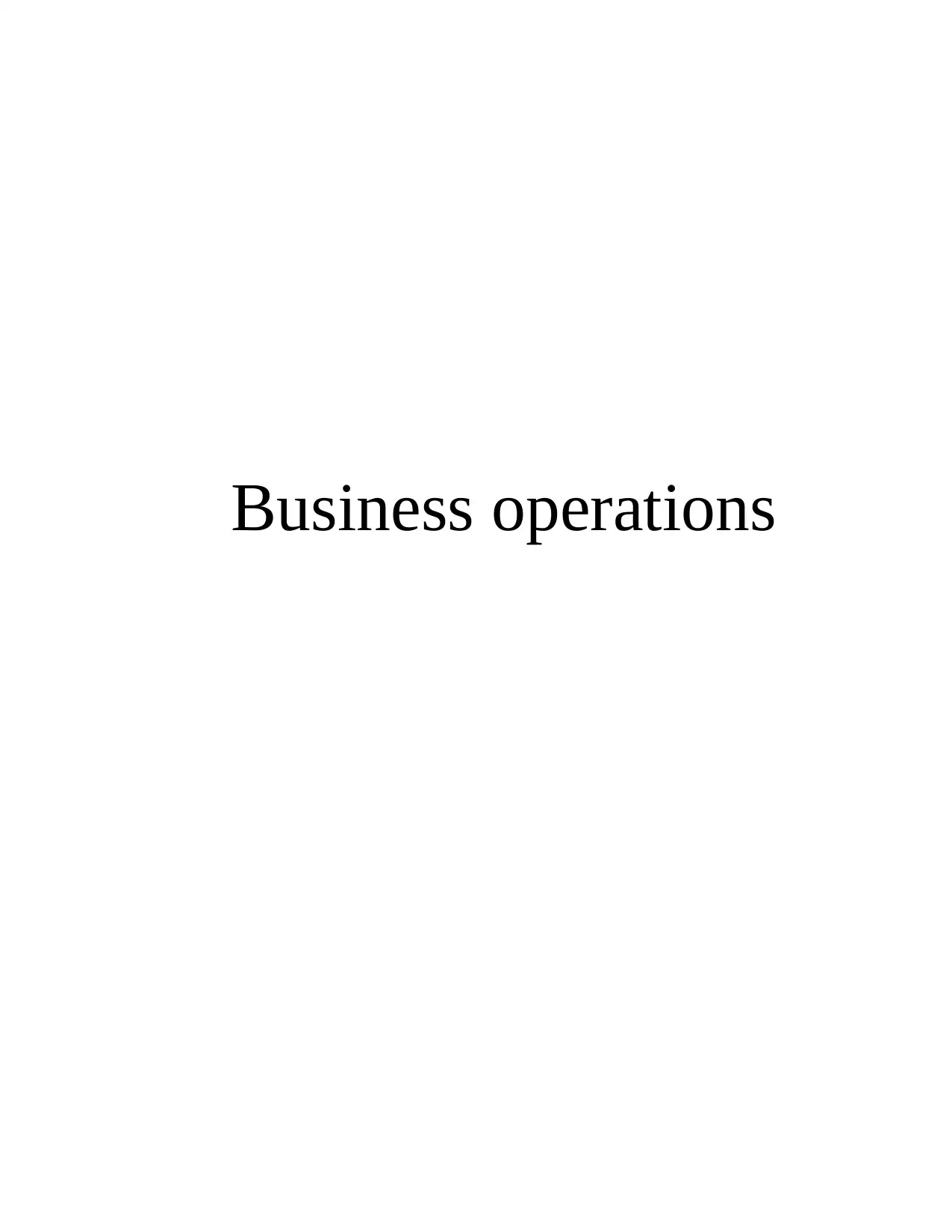
Business operations
Paraphrase This Document
Need a fresh take? Get an instant paraphrase of this document with our AI Paraphraser
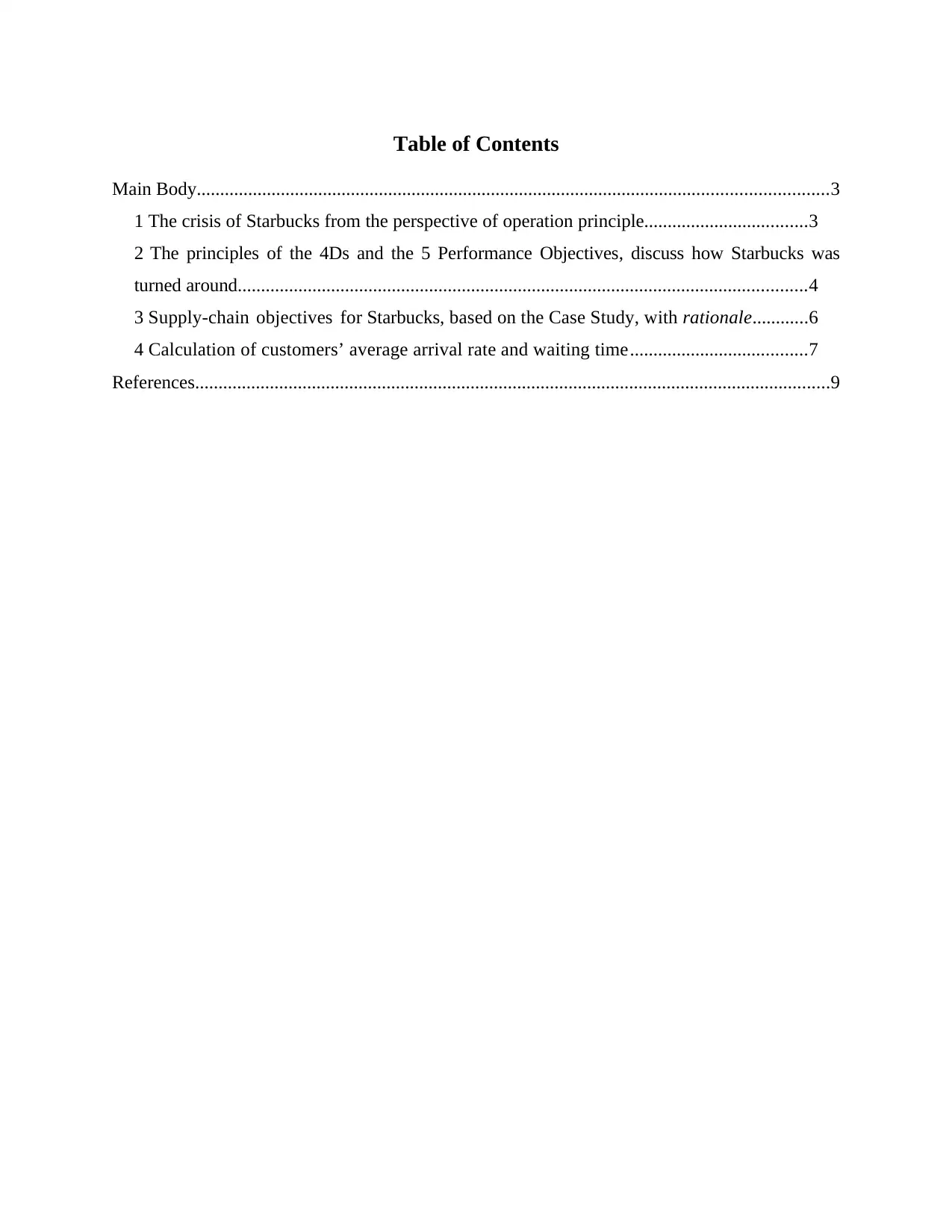
Table of Contents
Main Body.......................................................................................................................................3
1 The crisis of Starbucks from the perspective of operation principle...................................3
2 The principles of the 4Ds and the 5 Performance Objectives, discuss how Starbucks was
turned around..........................................................................................................................4
3 Supply-chain objectives for Starbucks, based on the Case Study, with rationale............6
4 Calculation of customers’ average arrival rate and waiting time......................................7
References........................................................................................................................................9
Main Body.......................................................................................................................................3
1 The crisis of Starbucks from the perspective of operation principle...................................3
2 The principles of the 4Ds and the 5 Performance Objectives, discuss how Starbucks was
turned around..........................................................................................................................4
3 Supply-chain objectives for Starbucks, based on the Case Study, with rationale............6
4 Calculation of customers’ average arrival rate and waiting time......................................7
References........................................................................................................................................9
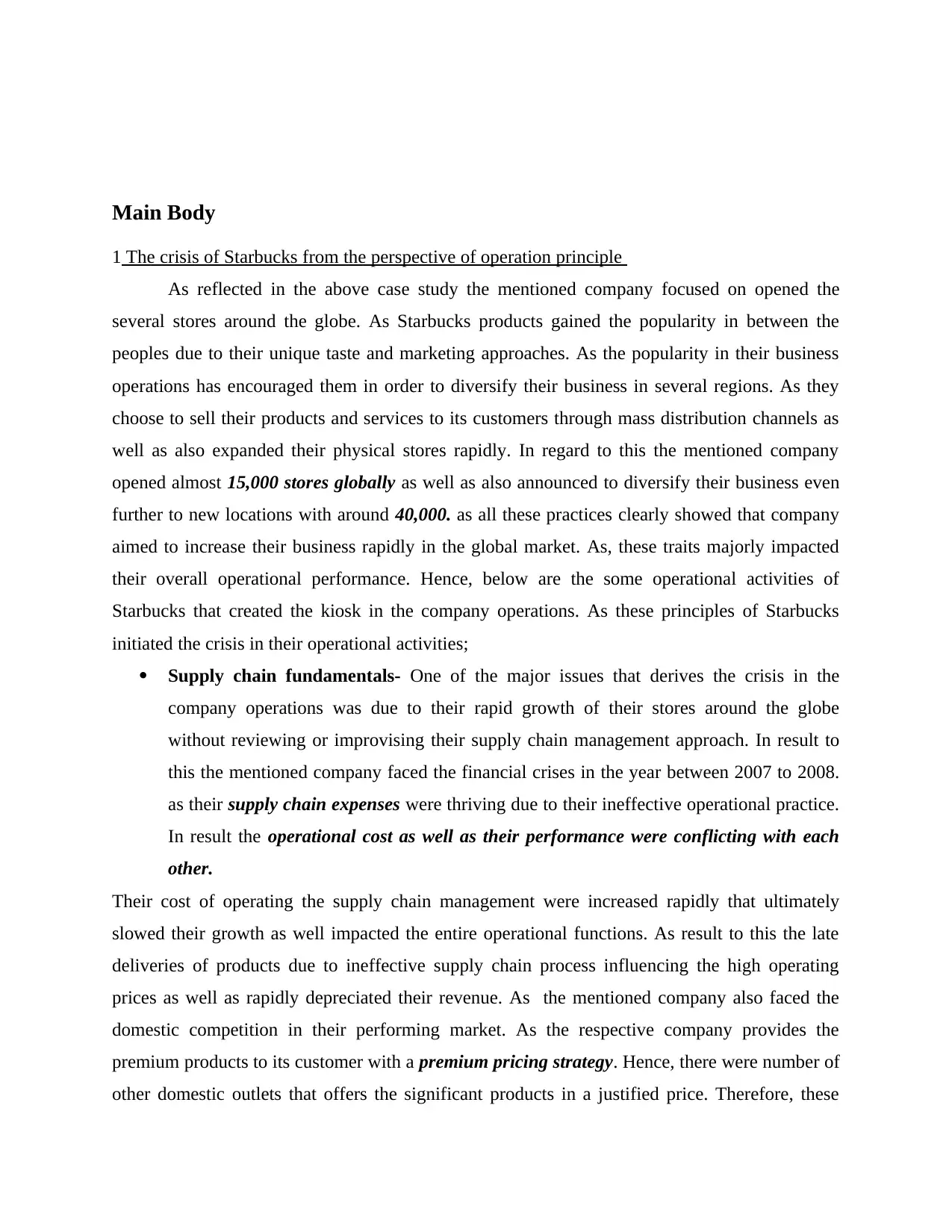
Main Body
1 The crisis of Starbucks from the perspective of operation principle
As reflected in the above case study the mentioned company focused on opened the
several stores around the globe. As Starbucks products gained the popularity in between the
peoples due to their unique taste and marketing approaches. As the popularity in their business
operations has encouraged them in order to diversify their business in several regions. As they
choose to sell their products and services to its customers through mass distribution channels as
well as also expanded their physical stores rapidly. In regard to this the mentioned company
opened almost 15,000 stores globally as well as also announced to diversify their business even
further to new locations with around 40,000. as all these practices clearly showed that company
aimed to increase their business rapidly in the global market. As, these traits majorly impacted
their overall operational performance. Hence, below are the some operational activities of
Starbucks that created the kiosk in the company operations. As these principles of Starbucks
initiated the crisis in their operational activities;
Supply chain fundamentals- One of the major issues that derives the crisis in the
company operations was due to their rapid growth of their stores around the globe
without reviewing or improvising their supply chain management approach. In result to
this the mentioned company faced the financial crises in the year between 2007 to 2008.
as their supply chain expenses were thriving due to their ineffective operational practice.
In result the operational cost as well as their performance were conflicting with each
other.
Their cost of operating the supply chain management were increased rapidly that ultimately
slowed their growth as well impacted the entire operational functions. As result to this the late
deliveries of products due to ineffective supply chain process influencing the high operating
prices as well as rapidly depreciated their revenue. As the mentioned company also faced the
domestic competition in their performing market. As the respective company provides the
premium products to its customer with a premium pricing strategy. Hence, there were number of
other domestic outlets that offers the significant products in a justified price. Therefore, these
1 The crisis of Starbucks from the perspective of operation principle
As reflected in the above case study the mentioned company focused on opened the
several stores around the globe. As Starbucks products gained the popularity in between the
peoples due to their unique taste and marketing approaches. As the popularity in their business
operations has encouraged them in order to diversify their business in several regions. As they
choose to sell their products and services to its customers through mass distribution channels as
well as also expanded their physical stores rapidly. In regard to this the mentioned company
opened almost 15,000 stores globally as well as also announced to diversify their business even
further to new locations with around 40,000. as all these practices clearly showed that company
aimed to increase their business rapidly in the global market. As, these traits majorly impacted
their overall operational performance. Hence, below are the some operational activities of
Starbucks that created the kiosk in the company operations. As these principles of Starbucks
initiated the crisis in their operational activities;
Supply chain fundamentals- One of the major issues that derives the crisis in the
company operations was due to their rapid growth of their stores around the globe
without reviewing or improvising their supply chain management approach. In result to
this the mentioned company faced the financial crises in the year between 2007 to 2008.
as their supply chain expenses were thriving due to their ineffective operational practice.
In result the operational cost as well as their performance were conflicting with each
other.
Their cost of operating the supply chain management were increased rapidly that ultimately
slowed their growth as well impacted the entire operational functions. As result to this the late
deliveries of products due to ineffective supply chain process influencing the high operating
prices as well as rapidly depreciated their revenue. As the mentioned company also faced the
domestic competition in their performing market. As the respective company provides the
premium products to its customer with a premium pricing strategy. Hence, there were number of
other domestic outlets that offers the significant products in a justified price. Therefore, these
⊘ This is a preview!⊘
Do you want full access?
Subscribe today to unlock all pages.

Trusted by 1+ million students worldwide
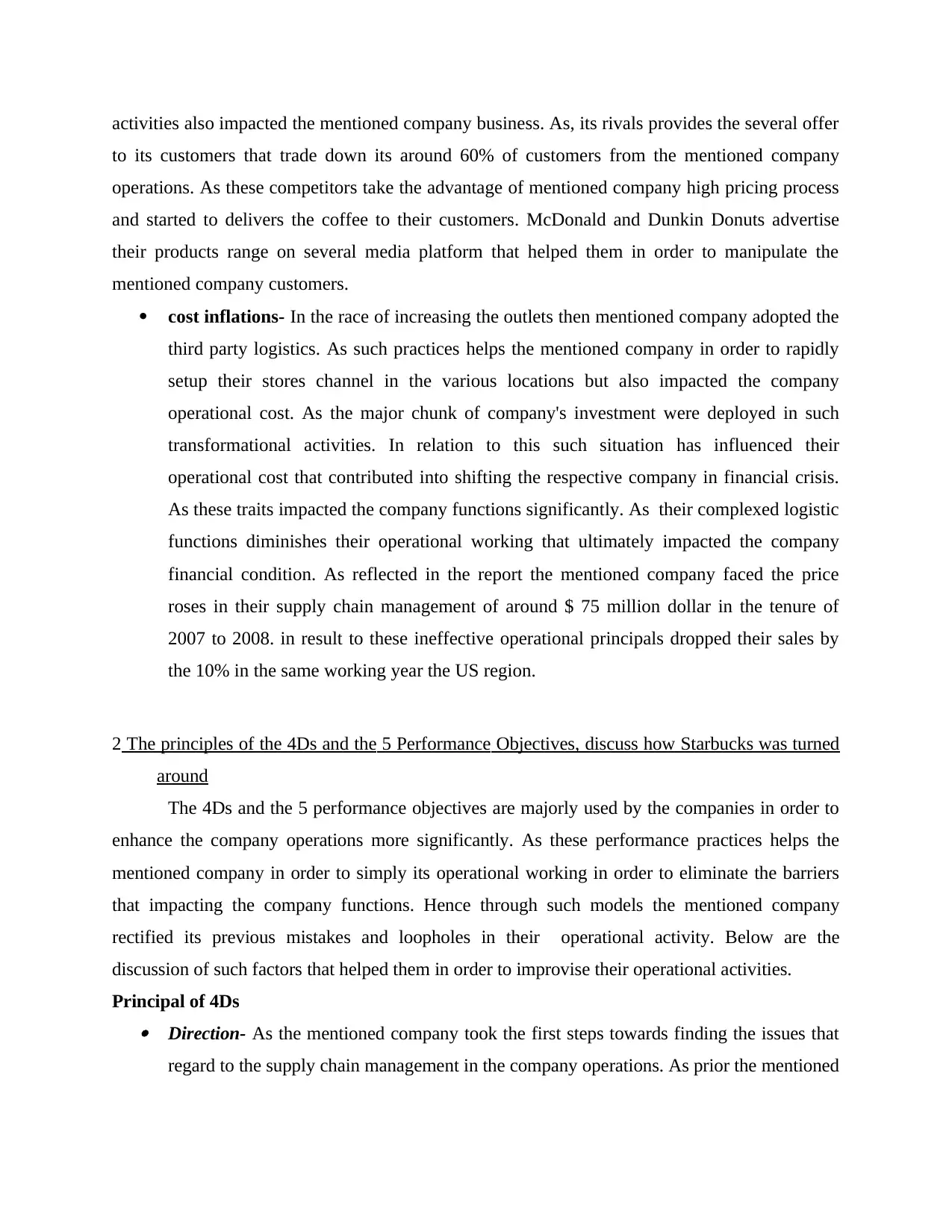
activities also impacted the mentioned company business. As, its rivals provides the several offer
to its customers that trade down its around 60% of customers from the mentioned company
operations. As these competitors take the advantage of mentioned company high pricing process
and started to delivers the coffee to their customers. McDonald and Dunkin Donuts advertise
their products range on several media platform that helped them in order to manipulate the
mentioned company customers.
cost inflations- In the race of increasing the outlets then mentioned company adopted the
third party logistics. As such practices helps the mentioned company in order to rapidly
setup their stores channel in the various locations but also impacted the company
operational cost. As the major chunk of company's investment were deployed in such
transformational activities. In relation to this such situation has influenced their
operational cost that contributed into shifting the respective company in financial crisis.
As these traits impacted the company functions significantly. As their complexed logistic
functions diminishes their operational working that ultimately impacted the company
financial condition. As reflected in the report the mentioned company faced the price
roses in their supply chain management of around $ 75 million dollar in the tenure of
2007 to 2008. in result to these ineffective operational principals dropped their sales by
the 10% in the same working year the US region.
2 The principles of the 4Ds and the 5 Performance Objectives, discuss how Starbucks was turned
around
The 4Ds and the 5 performance objectives are majorly used by the companies in order to
enhance the company operations more significantly. As these performance practices helps the
mentioned company in order to simply its operational working in order to eliminate the barriers
that impacting the company functions. Hence through such models the mentioned company
rectified its previous mistakes and loopholes in their operational activity. Below are the
discussion of such factors that helped them in order to improvise their operational activities.
Principal of 4Ds Direction- As the mentioned company took the first steps towards finding the issues that
regard to the supply chain management in the company operations. As prior the mentioned
to its customers that trade down its around 60% of customers from the mentioned company
operations. As these competitors take the advantage of mentioned company high pricing process
and started to delivers the coffee to their customers. McDonald and Dunkin Donuts advertise
their products range on several media platform that helped them in order to manipulate the
mentioned company customers.
cost inflations- In the race of increasing the outlets then mentioned company adopted the
third party logistics. As such practices helps the mentioned company in order to rapidly
setup their stores channel in the various locations but also impacted the company
operational cost. As the major chunk of company's investment were deployed in such
transformational activities. In relation to this such situation has influenced their
operational cost that contributed into shifting the respective company in financial crisis.
As these traits impacted the company functions significantly. As their complexed logistic
functions diminishes their operational working that ultimately impacted the company
financial condition. As reflected in the report the mentioned company faced the price
roses in their supply chain management of around $ 75 million dollar in the tenure of
2007 to 2008. in result to these ineffective operational principals dropped their sales by
the 10% in the same working year the US region.
2 The principles of the 4Ds and the 5 Performance Objectives, discuss how Starbucks was turned
around
The 4Ds and the 5 performance objectives are majorly used by the companies in order to
enhance the company operations more significantly. As these performance practices helps the
mentioned company in order to simply its operational working in order to eliminate the barriers
that impacting the company functions. Hence through such models the mentioned company
rectified its previous mistakes and loopholes in their operational activity. Below are the
discussion of such factors that helped them in order to improvise their operational activities.
Principal of 4Ds Direction- As the mentioned company took the first steps towards finding the issues that
regard to the supply chain management in the company operations. As prior the mentioned
Paraphrase This Document
Need a fresh take? Get an instant paraphrase of this document with our AI Paraphraser
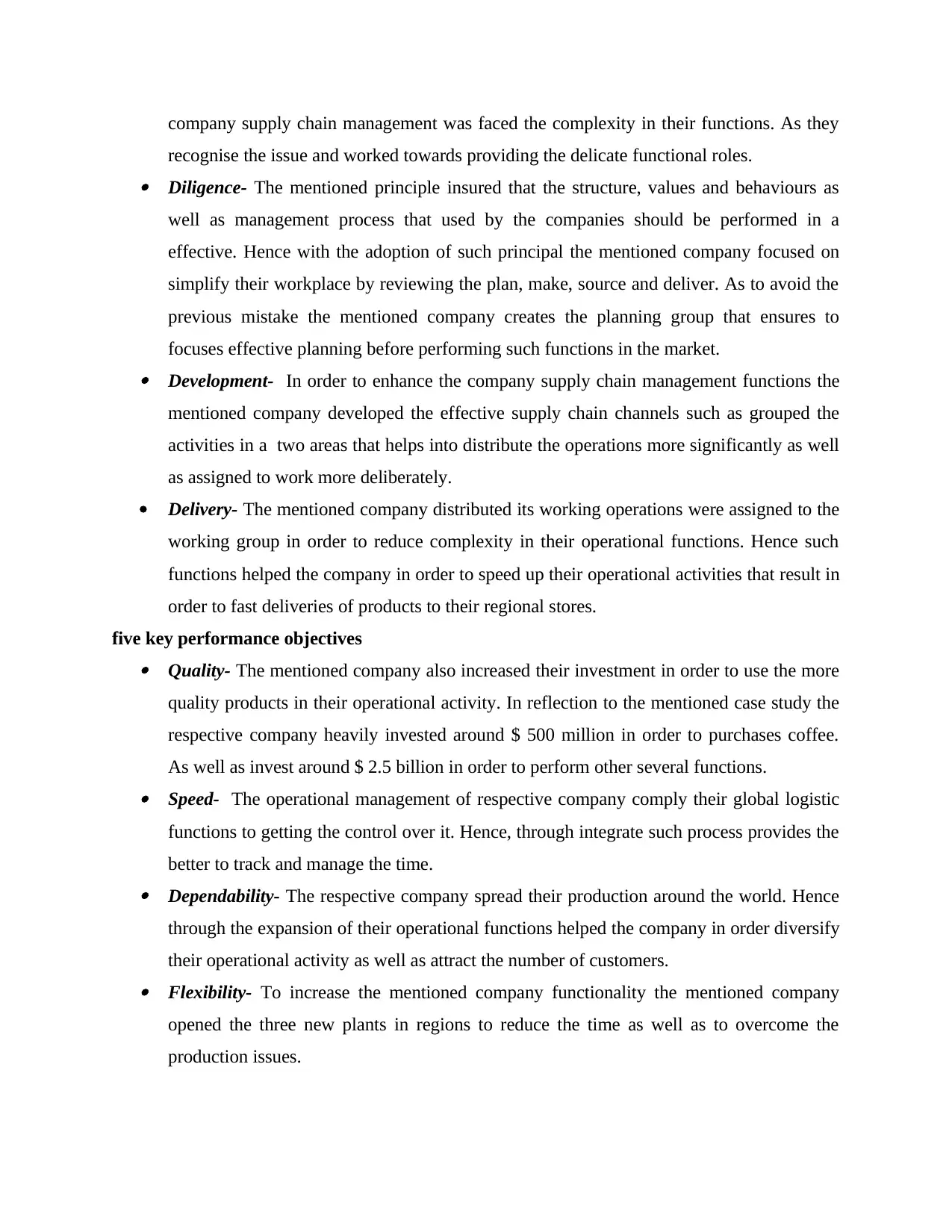
company supply chain management was faced the complexity in their functions. As they
recognise the issue and worked towards providing the delicate functional roles. Diligence- The mentioned principle insured that the structure, values and behaviours as
well as management process that used by the companies should be performed in a
effective. Hence with the adoption of such principal the mentioned company focused on
simplify their workplace by reviewing the plan, make, source and deliver. As to avoid the
previous mistake the mentioned company creates the planning group that ensures to
focuses effective planning before performing such functions in the market. Development- In order to enhance the company supply chain management functions the
mentioned company developed the effective supply chain channels such as grouped the
activities in a two areas that helps into distribute the operations more significantly as well
as assigned to work more deliberately.
Delivery- The mentioned company distributed its working operations were assigned to the
working group in order to reduce complexity in their operational functions. Hence such
functions helped the company in order to speed up their operational activities that result in
order to fast deliveries of products to their regional stores.
five key performance objectives Quality- The mentioned company also increased their investment in order to use the more
quality products in their operational activity. In reflection to the mentioned case study the
respective company heavily invested around $ 500 million in order to purchases coffee.
As well as invest around $ 2.5 billion in order to perform other several functions. Speed- The operational management of respective company comply their global logistic
functions to getting the control over it. Hence, through integrate such process provides the
better to track and manage the time. Dependability- The respective company spread their production around the world. Hence
through the expansion of their operational functions helped the company in order diversify
their operational activity as well as attract the number of customers. Flexibility- To increase the mentioned company functionality the mentioned company
opened the three new plants in regions to reduce the time as well as to overcome the
production issues.
recognise the issue and worked towards providing the delicate functional roles. Diligence- The mentioned principle insured that the structure, values and behaviours as
well as management process that used by the companies should be performed in a
effective. Hence with the adoption of such principal the mentioned company focused on
simplify their workplace by reviewing the plan, make, source and deliver. As to avoid the
previous mistake the mentioned company creates the planning group that ensures to
focuses effective planning before performing such functions in the market. Development- In order to enhance the company supply chain management functions the
mentioned company developed the effective supply chain channels such as grouped the
activities in a two areas that helps into distribute the operations more significantly as well
as assigned to work more deliberately.
Delivery- The mentioned company distributed its working operations were assigned to the
working group in order to reduce complexity in their operational functions. Hence such
functions helped the company in order to speed up their operational activities that result in
order to fast deliveries of products to their regional stores.
five key performance objectives Quality- The mentioned company also increased their investment in order to use the more
quality products in their operational activity. In reflection to the mentioned case study the
respective company heavily invested around $ 500 million in order to purchases coffee.
As well as invest around $ 2.5 billion in order to perform other several functions. Speed- The operational management of respective company comply their global logistic
functions to getting the control over it. Hence, through integrate such process provides the
better to track and manage the time. Dependability- The respective company spread their production around the world. Hence
through the expansion of their operational functions helped the company in order diversify
their operational activity as well as attract the number of customers. Flexibility- To increase the mentioned company functionality the mentioned company
opened the three new plants in regions to reduce the time as well as to overcome the
production issues.
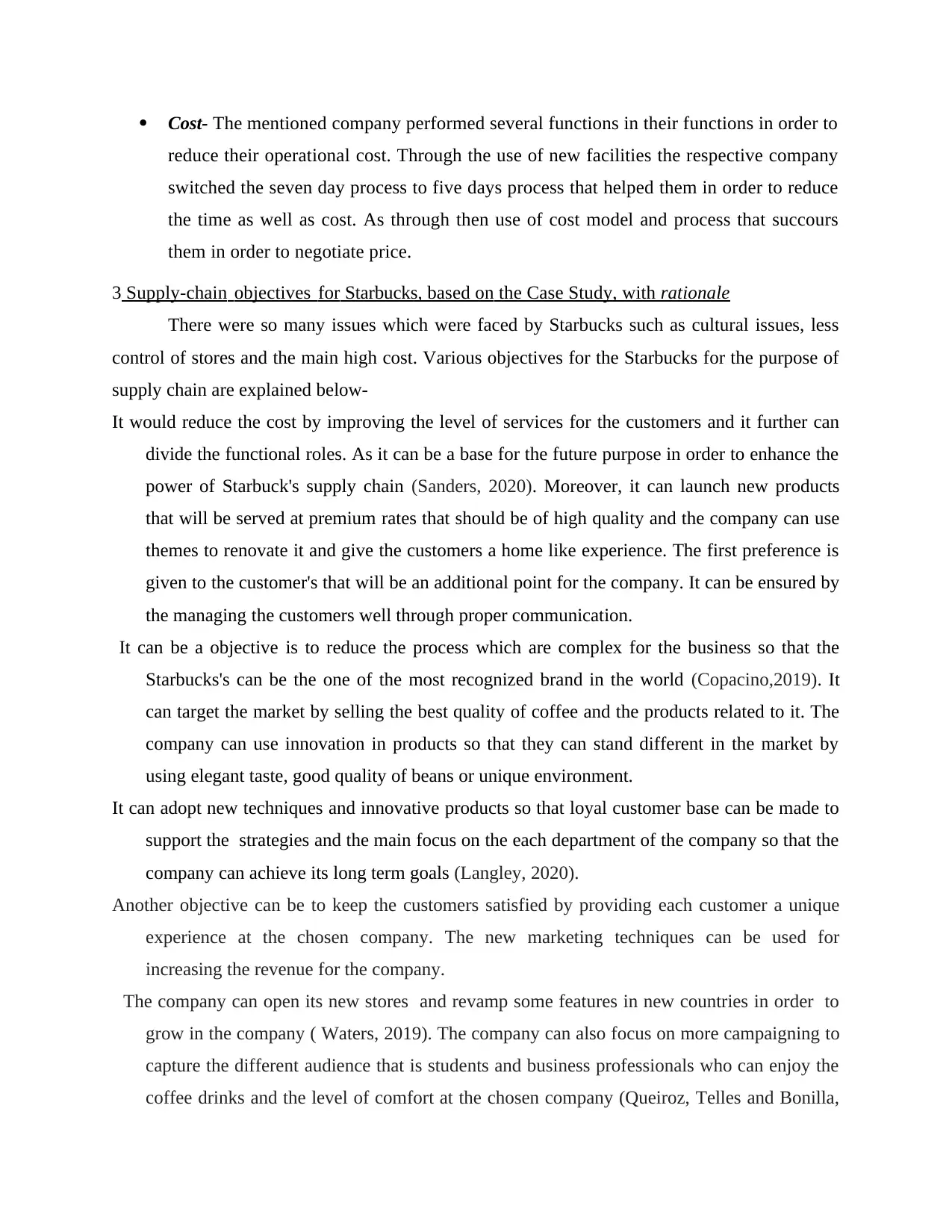
Cost- The mentioned company performed several functions in their functions in order to
reduce their operational cost. Through the use of new facilities the respective company
switched the seven day process to five days process that helped them in order to reduce
the time as well as cost. As through then use of cost model and process that succours
them in order to negotiate price.
3 Supply-chain objectives for Starbucks, based on the Case Study, with rationale
There were so many issues which were faced by Starbucks such as cultural issues, less
control of stores and the main high cost. Various objectives for the Starbucks for the purpose of
supply chain are explained below-
It would reduce the cost by improving the level of services for the customers and it further can
divide the functional roles. As it can be a base for the future purpose in order to enhance the
power of Starbuck's supply chain (Sanders, 2020). Moreover, it can launch new products
that will be served at premium rates that should be of high quality and the company can use
themes to renovate it and give the customers a home like experience. The first preference is
given to the customer's that will be an additional point for the company. It can be ensured by
the managing the customers well through proper communication.
It can be a objective is to reduce the process which are complex for the business so that the
Starbucks's can be the one of the most recognized brand in the world (Copacino,2019). It
can target the market by selling the best quality of coffee and the products related to it. The
company can use innovation in products so that they can stand different in the market by
using elegant taste, good quality of beans or unique environment.
It can adopt new techniques and innovative products so that loyal customer base can be made to
support the strategies and the main focus on the each department of the company so that the
company can achieve its long term goals (Langley, 2020).
Another objective can be to keep the customers satisfied by providing each customer a unique
experience at the chosen company. The new marketing techniques can be used for
increasing the revenue for the company.
The company can open its new stores and revamp some features in new countries in order to
grow in the company ( Waters, 2019). The company can also focus on more campaigning to
capture the different audience that is students and business professionals who can enjoy the
coffee drinks and the level of comfort at the chosen company (Queiroz, Telles and Bonilla,
reduce their operational cost. Through the use of new facilities the respective company
switched the seven day process to five days process that helped them in order to reduce
the time as well as cost. As through then use of cost model and process that succours
them in order to negotiate price.
3 Supply-chain objectives for Starbucks, based on the Case Study, with rationale
There were so many issues which were faced by Starbucks such as cultural issues, less
control of stores and the main high cost. Various objectives for the Starbucks for the purpose of
supply chain are explained below-
It would reduce the cost by improving the level of services for the customers and it further can
divide the functional roles. As it can be a base for the future purpose in order to enhance the
power of Starbuck's supply chain (Sanders, 2020). Moreover, it can launch new products
that will be served at premium rates that should be of high quality and the company can use
themes to renovate it and give the customers a home like experience. The first preference is
given to the customer's that will be an additional point for the company. It can be ensured by
the managing the customers well through proper communication.
It can be a objective is to reduce the process which are complex for the business so that the
Starbucks's can be the one of the most recognized brand in the world (Copacino,2019). It
can target the market by selling the best quality of coffee and the products related to it. The
company can use innovation in products so that they can stand different in the market by
using elegant taste, good quality of beans or unique environment.
It can adopt new techniques and innovative products so that loyal customer base can be made to
support the strategies and the main focus on the each department of the company so that the
company can achieve its long term goals (Langley, 2020).
Another objective can be to keep the customers satisfied by providing each customer a unique
experience at the chosen company. The new marketing techniques can be used for
increasing the revenue for the company.
The company can open its new stores and revamp some features in new countries in order to
grow in the company ( Waters, 2019). The company can also focus on more campaigning to
capture the different audience that is students and business professionals who can enjoy the
coffee drinks and the level of comfort at the chosen company (Queiroz, Telles and Bonilla,
⊘ This is a preview!⊘
Do you want full access?
Subscribe today to unlock all pages.

Trusted by 1+ million students worldwide
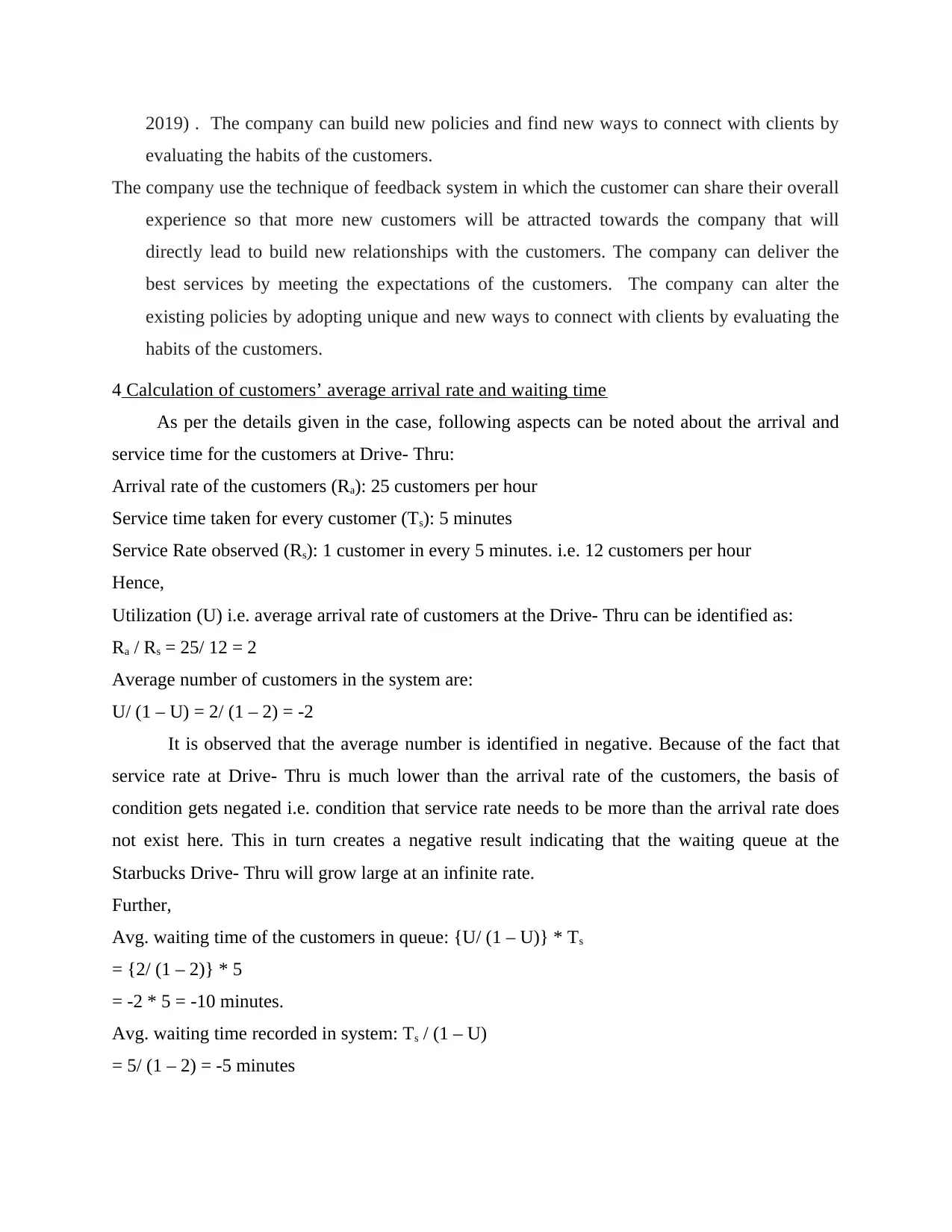
2019) . The company can build new policies and find new ways to connect with clients by
evaluating the habits of the customers.
The company use the technique of feedback system in which the customer can share their overall
experience so that more new customers will be attracted towards the company that will
directly lead to build new relationships with the customers. The company can deliver the
best services by meeting the expectations of the customers. The company can alter the
existing policies by adopting unique and new ways to connect with clients by evaluating the
habits of the customers.
4 Calculation of customers’ average arrival rate and waiting time
As per the details given in the case, following aspects can be noted about the arrival and
service time for the customers at Drive- Thru:
Arrival rate of the customers (Ra): 25 customers per hour
Service time taken for every customer (Ts): 5 minutes
Service Rate observed (Rs): 1 customer in every 5 minutes. i.e. 12 customers per hour
Hence,
Utilization (U) i.e. average arrival rate of customers at the Drive- Thru can be identified as:
Ra / Rs = 25/ 12 = 2
Average number of customers in the system are:
U/ (1 – U) = 2/ (1 – 2) = -2
It is observed that the average number is identified in negative. Because of the fact that
service rate at Drive- Thru is much lower than the arrival rate of the customers, the basis of
condition gets negated i.e. condition that service rate needs to be more than the arrival rate does
not exist here. This in turn creates a negative result indicating that the waiting queue at the
Starbucks Drive- Thru will grow large at an infinite rate.
Further,
Avg. waiting time of the customers in queue: {U/ (1 – U)} * Ts
= {2/ (1 – 2)} * 5
= -2 * 5 = -10 minutes.
Avg. waiting time recorded in system: Ts / (1 – U)
= 5/ (1 – 2) = -5 minutes
evaluating the habits of the customers.
The company use the technique of feedback system in which the customer can share their overall
experience so that more new customers will be attracted towards the company that will
directly lead to build new relationships with the customers. The company can deliver the
best services by meeting the expectations of the customers. The company can alter the
existing policies by adopting unique and new ways to connect with clients by evaluating the
habits of the customers.
4 Calculation of customers’ average arrival rate and waiting time
As per the details given in the case, following aspects can be noted about the arrival and
service time for the customers at Drive- Thru:
Arrival rate of the customers (Ra): 25 customers per hour
Service time taken for every customer (Ts): 5 minutes
Service Rate observed (Rs): 1 customer in every 5 minutes. i.e. 12 customers per hour
Hence,
Utilization (U) i.e. average arrival rate of customers at the Drive- Thru can be identified as:
Ra / Rs = 25/ 12 = 2
Average number of customers in the system are:
U/ (1 – U) = 2/ (1 – 2) = -2
It is observed that the average number is identified in negative. Because of the fact that
service rate at Drive- Thru is much lower than the arrival rate of the customers, the basis of
condition gets negated i.e. condition that service rate needs to be more than the arrival rate does
not exist here. This in turn creates a negative result indicating that the waiting queue at the
Starbucks Drive- Thru will grow large at an infinite rate.
Further,
Avg. waiting time of the customers in queue: {U/ (1 – U)} * Ts
= {2/ (1 – 2)} * 5
= -2 * 5 = -10 minutes.
Avg. waiting time recorded in system: Ts / (1 – U)
= 5/ (1 – 2) = -5 minutes
Paraphrase This Document
Need a fresh take? Get an instant paraphrase of this document with our AI Paraphraser
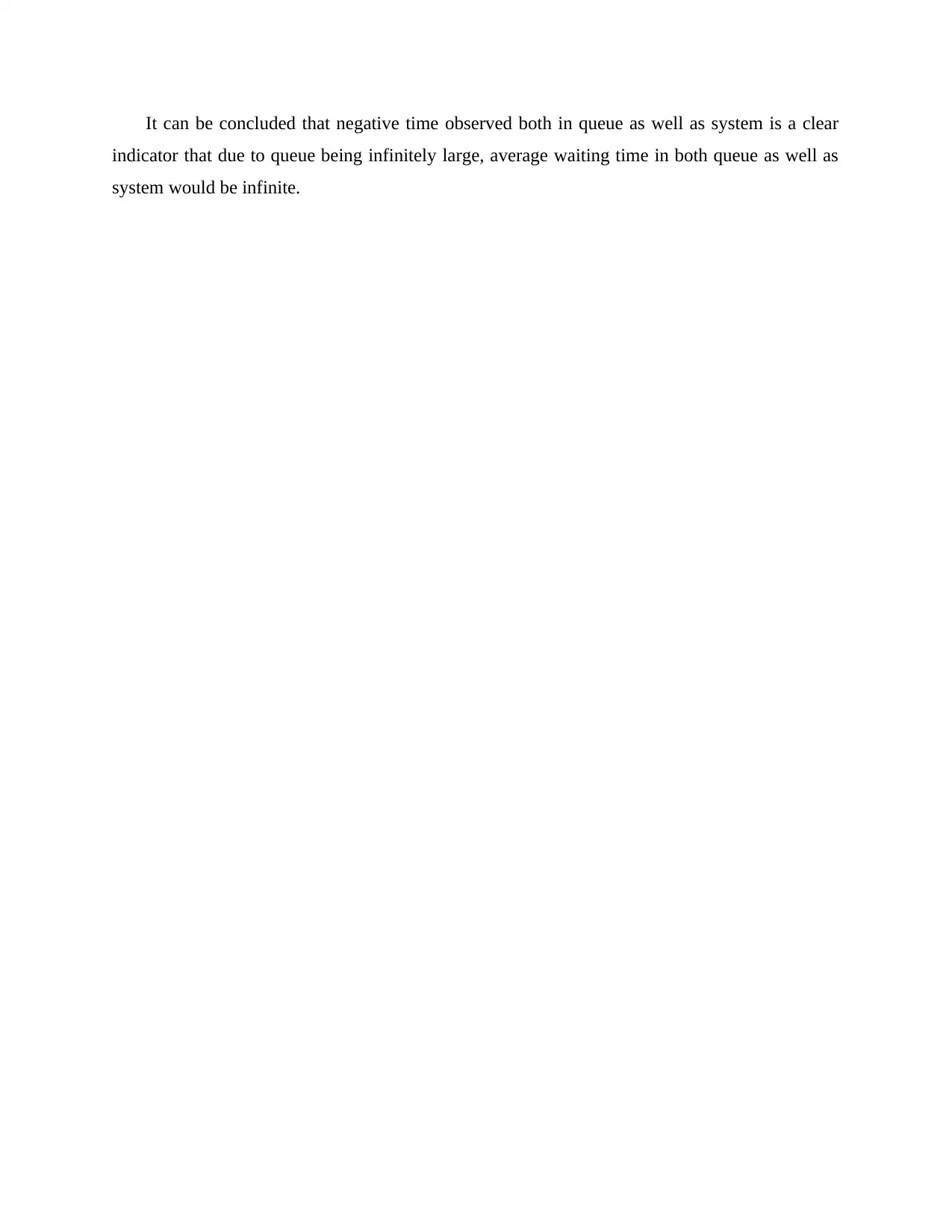
It can be concluded that negative time observed both in queue as well as system is a clear
indicator that due to queue being infinitely large, average waiting time in both queue as well as
system would be infinite.
indicator that due to queue being infinitely large, average waiting time in both queue as well as
system would be infinite.
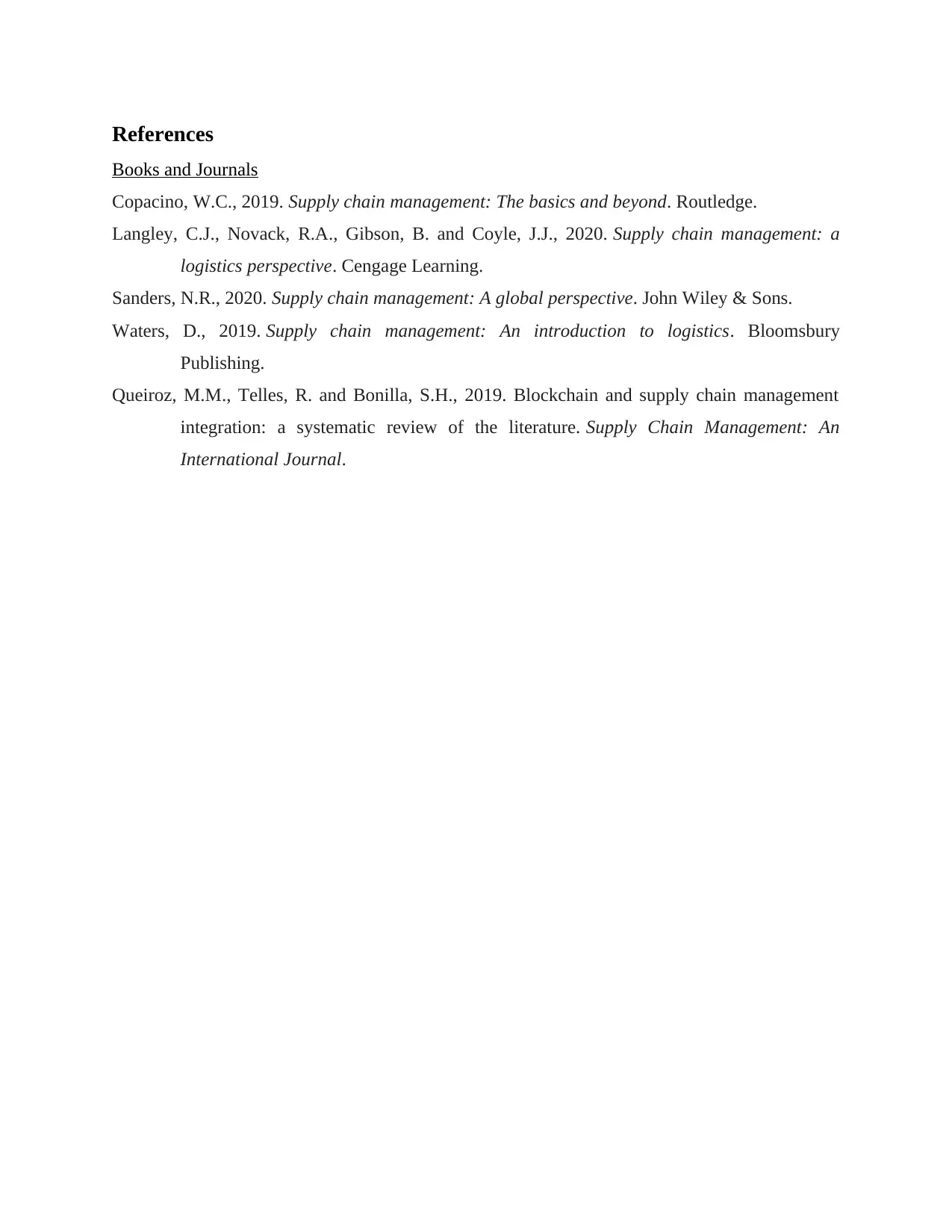
References
Books and Journals
Copacino, W.C., 2019. Supply chain management: The basics and beyond. Routledge.
Langley, C.J., Novack, R.A., Gibson, B. and Coyle, J.J., 2020. Supply chain management: a
logistics perspective. Cengage Learning.
Sanders, N.R., 2020. Supply chain management: A global perspective. John Wiley & Sons.
Waters, D., 2019. Supply chain management: An introduction to logistics. Bloomsbury
Publishing.
Queiroz, M.M., Telles, R. and Bonilla, S.H., 2019. Blockchain and supply chain management
integration: a systematic review of the literature. Supply Chain Management: An
International Journal.
Books and Journals
Copacino, W.C., 2019. Supply chain management: The basics and beyond. Routledge.
Langley, C.J., Novack, R.A., Gibson, B. and Coyle, J.J., 2020. Supply chain management: a
logistics perspective. Cengage Learning.
Sanders, N.R., 2020. Supply chain management: A global perspective. John Wiley & Sons.
Waters, D., 2019. Supply chain management: An introduction to logistics. Bloomsbury
Publishing.
Queiroz, M.M., Telles, R. and Bonilla, S.H., 2019. Blockchain and supply chain management
integration: a systematic review of the literature. Supply Chain Management: An
International Journal.
⊘ This is a preview!⊘
Do you want full access?
Subscribe today to unlock all pages.

Trusted by 1+ million students worldwide

1 out of 10
Related Documents
Your All-in-One AI-Powered Toolkit for Academic Success.
+13062052269
info@desklib.com
Available 24*7 on WhatsApp / Email
![[object Object]](/_next/static/media/star-bottom.7253800d.svg)
Unlock your academic potential
Copyright © 2020–2025 A2Z Services. All Rights Reserved. Developed and managed by ZUCOL.



